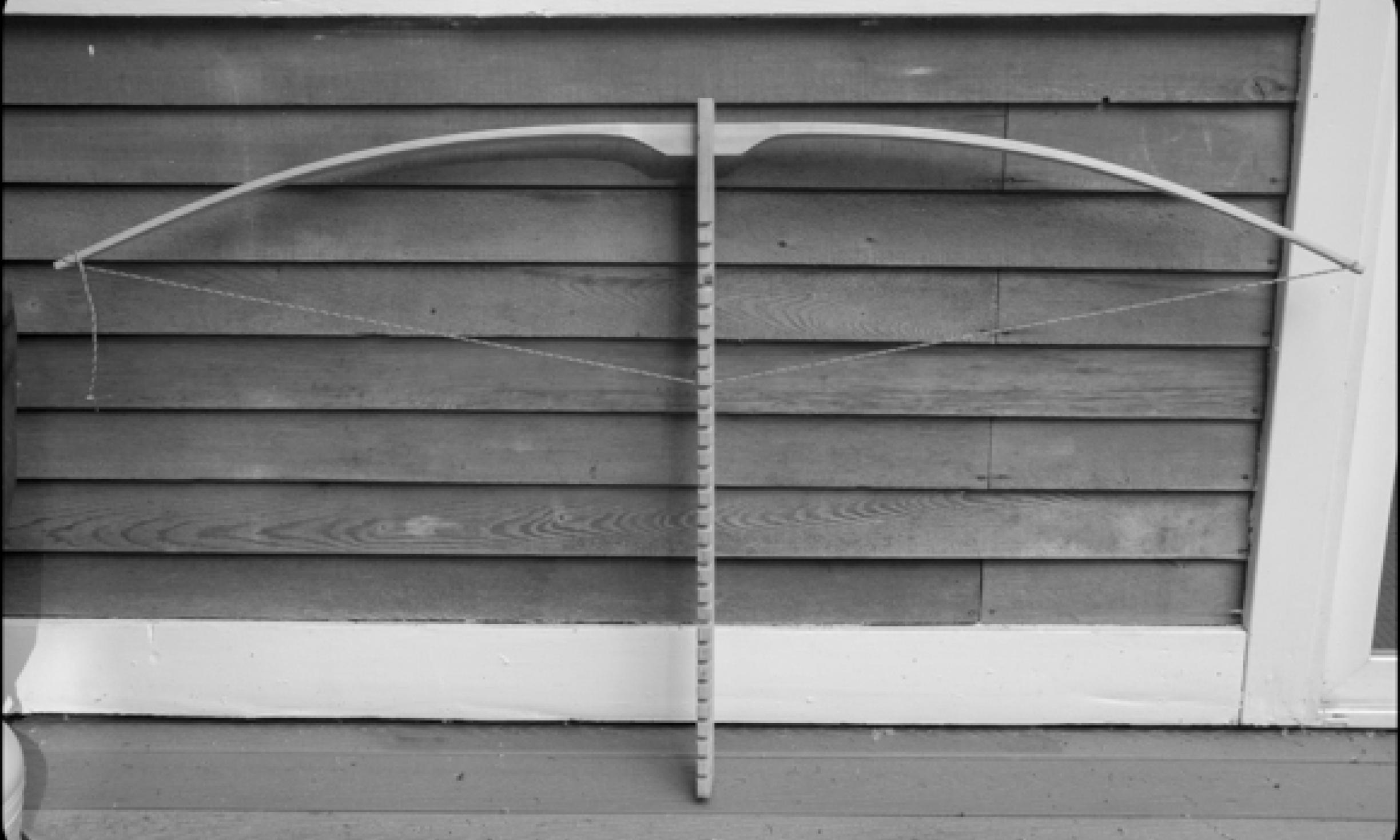Miss Part 1? What about Part 2?
Things are getting interesting. Here’s an update of where we are in the process of how to make a bow and arrow.
Our bow:
- is fully dried
- has an ultra-smooth back
- is starting to bend on the top and bottom limb
This is a good place to be. We’ve laid out our bow and are starting to learn how to remove wood from the belly evenly and efficiently.
Our bow is starting to bend when we use the floor tillering method from Part 2. It is time to start bending our bow increasingly – but only in small increments. It’s time to put a string on our wood bow!
Making a Bow String
There are many ways to make a string for a traditional bow. You could simply get a piece of nylon string or 550 paracord that is a little longer than your bow, carve some grooves near the tips of your bow, and attach the string.
What’s the problem with that?
Well, think of the job of a bow string: to help cast an arrow as fast, accurate, and safe as possible.
It might not seem like it, but a nylon string is relatively heavy. A heavy string means that our arrow is going to be cast much slower than if we were using a light string.
Flight shooters (bowyers that shoot arrows in the range of 300-400 yards!), use ultralight – and therefore weaker – strings. We don’t need to go that far, as that can compromise the safety of our bow.
Our goal is to create a string that is lightweight, but strong. The traditional bowstring was made from sinew (animal tendon) or animal intestines. Natural fibers were also used, but they are not as strong and can take many hours to make.
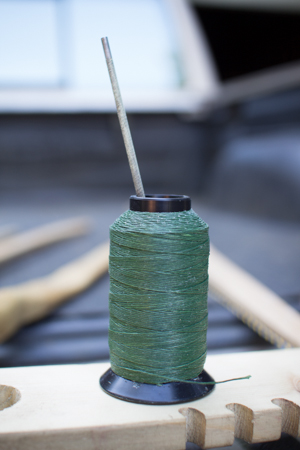
The modern material of choice is a waxed polyester string: Dacron B-50. It comes in large spools and is about the diameter of thick dental floss. Depending on the strength of the bow, you will want to use 12-16 strands of Dacron B-50. For a bow that draws 50 pounds, I use 14 strands.
Here’s how to make a bow string. Set up a “jig” for measuring how long to make your bowstring. Pound two nails into a board spread out the length of your bow PLUS 18 inches. Then with one spool of Dacron, wrap around the nails until you have 7 strands. Cut both ends.
Repeat this with a different colored spool of Dacron.
At this point, you have two different-colored bundles of 7 strands. If you have made cordage using the reverse-wrap method, you are in luck. If not, then you have some learnin’ to do.
One end of our string will have a loop. This loop will be the side that we use to string and unstring our bow. This will live on the top of your bow. The other side will have a simple knot that is easy to tie and to untie. We will adjust this knot several times in the process of making our bow and arrow.
Let’s create the loop that goes around one end of your bow. If you want to be fancy-like, call it by its proper name: the Flemish loop. It kind of gets caught in your throat, doesn’t it?
Put your two bundles of 7 strands together. Starting 8 inches in from one end of your string, start making cordage TOWARD the short end of the string – in the opposite way that is intuitive.
You only need 2-3 inches of cordage, but it needs to be in the middle of your string. You want to have 4-5 inches of “tail” that is unwrapped. You will see why in a moment.
Make sure the loop is not too big or too small. Grab your bow and size the loop-to-be on one end of your bow. You only want to be able to slide it down about 6 inches. If the loop is too big, unwrap some cordage. If it doesn’t fit over the end, add a few more wraps of cordage.
Now, join the unwrapped section on either side of the cordage. This is where having two different colored bundles comes in handy. Join the same colored strands together and continue wrapping down the string. If done correctly you will have a Flemish loop!
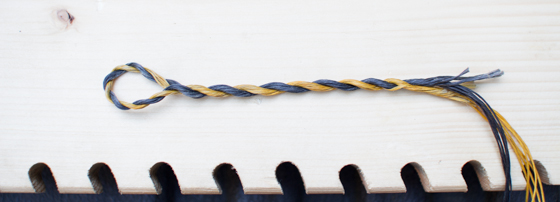
You have the option to continue to wrap the entire string. Or you can wrap another 18” past the loop so and leave it unwrapped. For now, just tie off the end with a simple square knot.
Making String Grooves
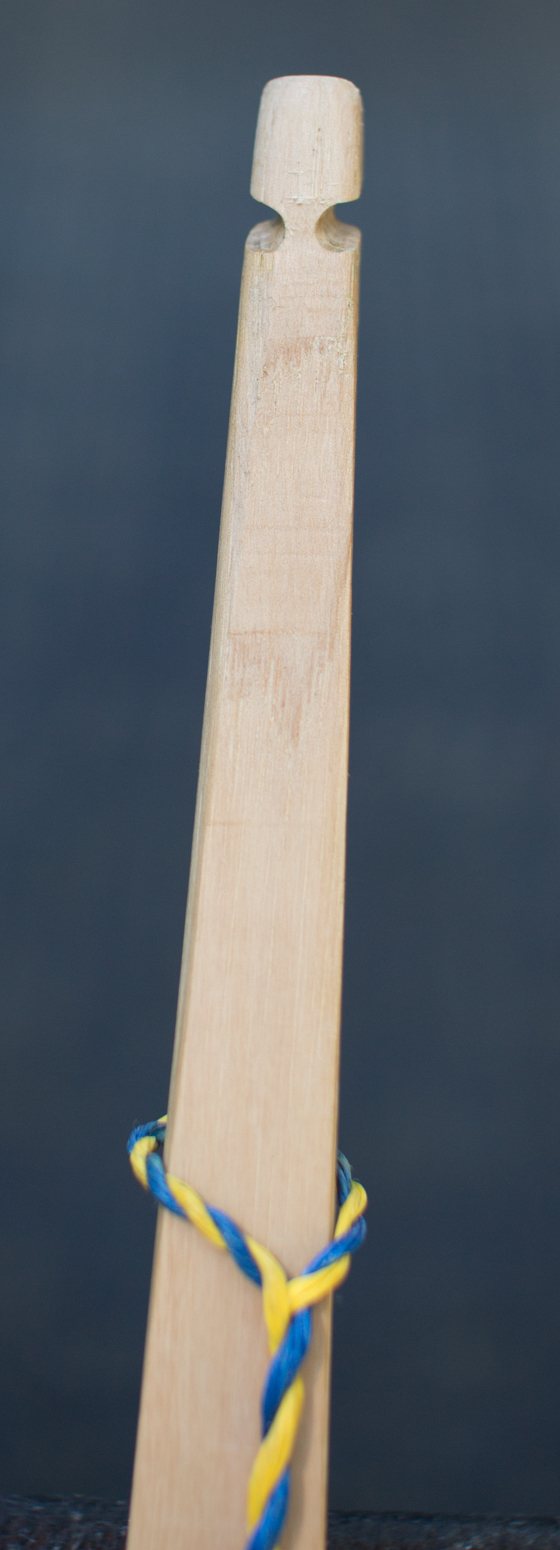
You might be wondering how to attach your freshly minted string to your bow; you need to create string grooves near the bow tips. String grooves should be just deep enough that your string will rest on without falling out of the groove. The biggest challenge is to get these grooves to be symmetrical, as you will need to make one on both sides of your limb tips.
On the back of your bow, make a mark 1/2” down from the tip. On the belly, make a mark 3/4” down from the tip. Repeat on the opposite side AND on the other tip. Make sure that the lower end is on the belly side.
You can use a knife to carve the grooves, but my preferred tool is a 1/8” chain saw file. Go slow and make sure that the bottom of each groove matches the other side.
To finish the groove, take some 100 grit sandpaper and round off the sharp edges of your grooves. This will prevent your string from being damaged from the wear and tear of stringing and unstringing your bow.
Tying a String to your Bow
Last, we need to tie the string to your bow. One end is easy: simply place your Flemish loop into the groove. Nice!
Use a timber hitch for the other end. The timber hitch is an awesome knot. If you use the bow drill fire starting technique, this is a good knot to use for your bow.
Learn the timber hitch at my favorite knot website.
Loose-String Tillering
Whoa. There’s a string on your bow! This is an exciting time in the process of making a bow and arrow. You might even be tempted to pull your bow back just to see what happens. If you have this urge, I recommend you go inside and stick your head in the freezer for 7-10 minutes.
You’ve made it this far. No need to get all crazy and ruin your bow.
At this point, you only want to flex your bow as far as you were floor tillering – maybe 3-4 inches.
As Yoda would say in a slightly creepy voice, “Patience.”
In Part 2, we talked about the main goals of tillering:
- Keeping our two limbs equal in strength
- Maintaining a uniform bend in each limb.
Another goal is to train our bow. That’s why this early stage is so critical. As we bend our bow further and further, we are compressing the fibers of the belly of our bow. If we bend our bow too far when it’s not ready, the bow will remember it. It can cause a permanent weak spot or, if it’s extreme, snap our bow.
When the first two goals are met, our bow can be bent increasingly in 1-2 inch increments.
But what if our bow limbs are not equal?
Then do not bend your bow any further.
With a loose string attached, place your bow on a tillering board. Make sure your bow is centered on the board – you can place a mark in the center of your bow and the center of the tillering board.
Now flex your bow in a smooth motion so the tips bend 2-3 inches. Place the string in a notch or on a nail and stand back a few paces. How do the limbs look compared to one another?
Is one side pulling down significantly farther? How does the top limb look?
What about the bottom? Is there a smooth bend or are there “hinges”?
This can be really challenging to see at first, but don’t despair. The details of your bow will get easier to see the further into tillering you get.
The goal here is to get each limb taking an even amount of strain before pulling your bow any further. If you are a perfectionist, but save that for later. Go for close enough.
If you haven’t already, it’s time to mark the top and bottom limbs. It doesn’t matter which is which at this point. You do want the Flemish loop on the top, though. I simply place a “T” and a “B” on each respective limb. This will help you remember which limb you are working on.
While your bow is on the tillering board, get into the habit of marking areas where the bow is bending more or less. It’s totally worth it to liberally use a pencil. You might remember all the subtleties of your bow at first, but after repeating this process over and again you’ll be glad you made notes while your bow was on the tillering board.
If the limbs are relatively close and there are no obvious hinges or weak spots, then it’s time to take the bow off the tillering board and make some wood shavings.
Safety Note: It is tempting to leave your string tied to your bow. It saves time, right? I recommend removing the string each time you are removing wood. I have cut strings with my tools and it is a real bummer. Also, your string is waxed. It has a tendency to pick up dust and shavings. This will weaken your string, so keep it off of the ground.
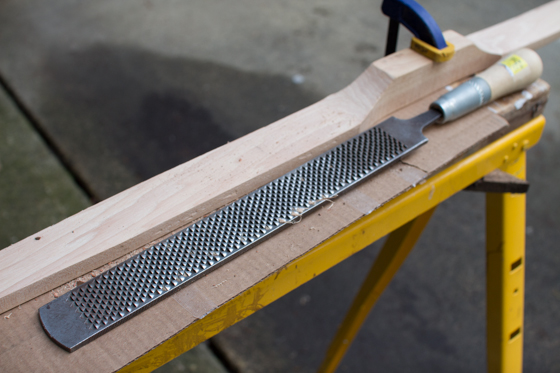
At this stage, you likely still have some wood to remove. My technique for wood removal is to alternate between the Ferrier’s rasp and a Nicholson bastard file. Use the rasp side for most of your effort and then finish each session with the file side. Remove wood evenly and pay attention to how many passes of your rasp you make on each side.
I like to count, so I will do 50 passes on each side and see how much that affects my bow. Put your string back on and place it on the tillering board. Bend it to the same place as before. Is it easier to pull? Is there virtually no difference at all?
You want to find the balance of removing wood so you notice a difference, but not so much that you notice a BIG difference. If your bow limbs are uneven, then it might take 50 passes on the lighter side and 75 passes on the heavier side.
You are working towards getting your bow to bend equal and consistently at 6 inches of bend. That means the tips of your bow bends 6 full inches from the back of the bow.
Here’s a tip to see how far your limbs are bending. Place your bow on a tillering board and pull it down 3-4 inches. Get a straight piece of wood that is a foot longer than your bow. Place it on the back of your bow, making sure it is centered. You can now measure the distance that each limb has traveled. This will allow you to look at how the top and bottom limbs compare to one another.
Before pulling your bow further, your limbs should ideally be within 1/2” of one another. Sometimes one limb takes more work to make it bend equal to the other.
You are making progress!
Keep removing wood from the belly. Check your results often and look for any bumps or valleys that YOU are creating. Check the thickness of both sides of your bow. I have gotten into the habit of using both my right and left hands so that I don’t thin one side more than another.
Be patient and take breaks as you need to. Remember to pick your head up every once in a while. Was that a bird that just flew by? Did the sun already set? How many planes have flown by since you started working on your bow?
Be aware of your bow. But don’t neglect the rest of the world while you’re at it.
Stringing your bow
When your bow is bending consistently (aka without any hinges) at a full six inches on both sides, it’s time to string your bow. This can be very exciting and it can be a little nerve-wracking.
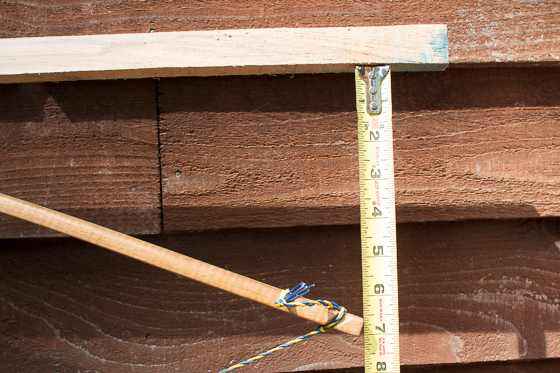
First, take your Flemish loop out of the string groove. Lower it about 2 inches from the bottom of the groove. Now undo the other side and retie your timber hitch. If you have several inches of tail, you can wrap it around the bow and tie it off with a simple knot.
I like to use the “Step-through method” to string bows. With your bow at a steep angle and the back of the bow facing the ground, step between the string and the bow with your left leg.
Try to imitate how your bow normally bends. Place the handle section on your upper thigh and shift your weight so there is a little tension on your bow. Now bend the top limb and the bottom limb as evenly as you can. Use your hand and your body weight at the same time.
With your bow bent, slide the loop upwards into the string groove. If this is really hard, DO NOT force it. It’s important to string your bow as soon as you can, but there’s no reason to rush it.
If you are able to string your bow, nice work!
Be aware, your string will likely stretch and you will need to repeat this process a couple of times. Remove the loop, shorten your string and restring your bow. These first several attempts will probably be awkward. It gets easier over time.
When your bow is complete, you want to have 6-7 inches measured from the back of your bow to the taut string. But for your first attempt, 2-3 inches is enough to move forward.
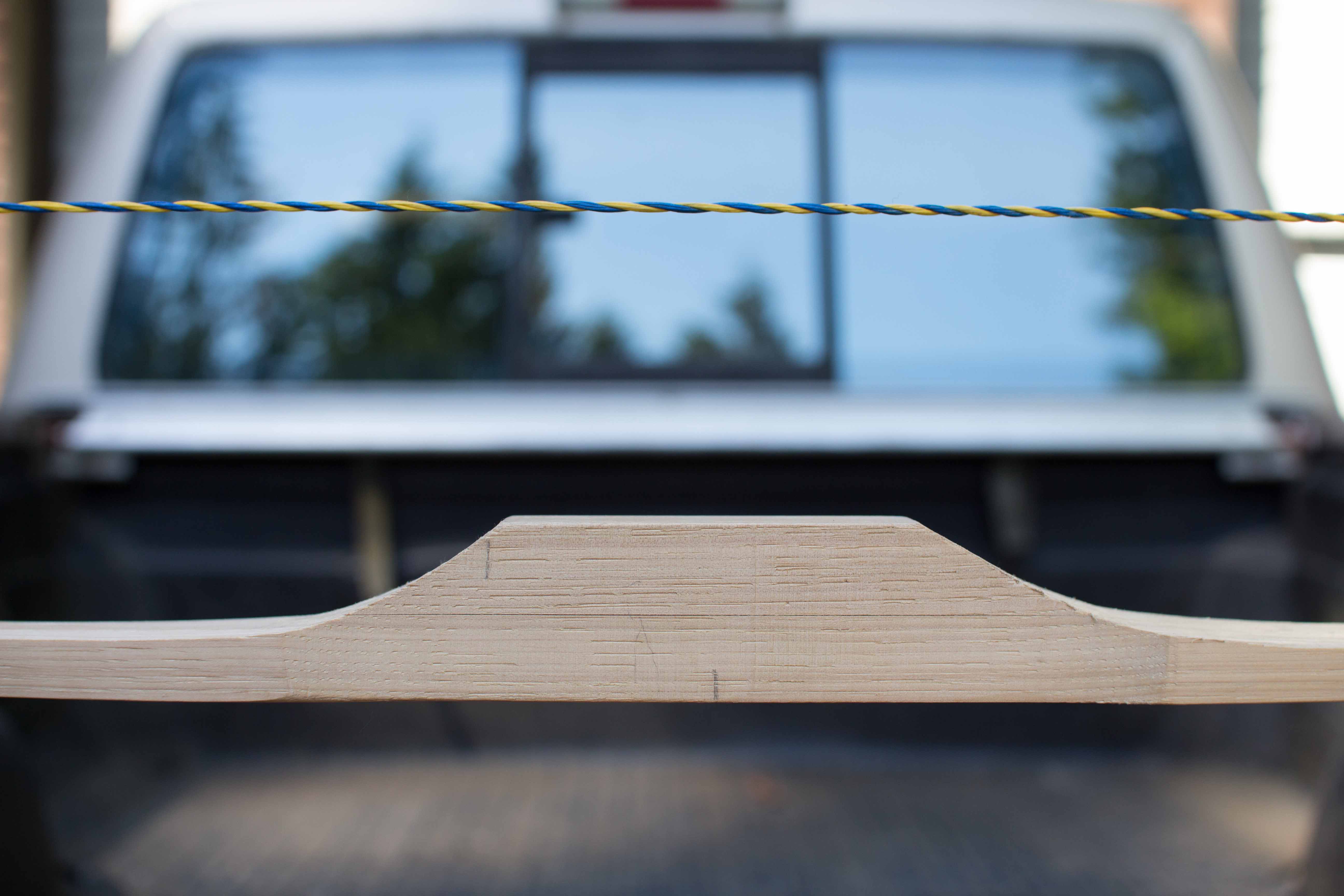 Your bow should be getting easier to pull, but not so light that it feels really easy.
Your bow should be getting easier to pull, but not so light that it feels really easy.
You are now at the final tillering stage! The finish line is so close.
It’s probably time for a break. In the meantime, it’s important to leave your bow unstrung in a dry, protected area.
In Part 4 of How to Make a Bow and Arrow, we will cover Measuring Bow Weight, Final Tillering, and Finishing your bow.
